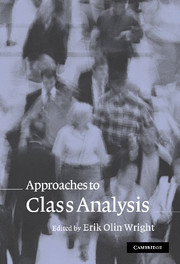Book contents
- Frontmatter
- Contents
- List of figures
- List of tables
- List of contributors
- Introduction
- 1 Foundations of a neo-Marxist class analysis
- 2 Foundations of a neo-Weberian class analysis
- 3 Foundations of a neo-Durkheimian class analysis
- 4 Foundations of Pierre Bourdieu's class analysis
- 5 Foundations of a rent-based class analysis
- 6 Foundations of a post-class analysis
- Conclusion: If “class” is the answer, what is the question?
- References
- Index
4 - Foundations of Pierre Bourdieu's class analysis
Published online by Cambridge University Press: 22 September 2009
- Frontmatter
- Contents
- List of figures
- List of tables
- List of contributors
- Introduction
- 1 Foundations of a neo-Marxist class analysis
- 2 Foundations of a neo-Weberian class analysis
- 3 Foundations of a neo-Durkheimian class analysis
- 4 Foundations of Pierre Bourdieu's class analysis
- 5 Foundations of a rent-based class analysis
- 6 Foundations of a post-class analysis
- Conclusion: If “class” is the answer, what is the question?
- References
- Index
Summary
At the time of his death in January 2002, Pierre Bourdieu was perhaps the most prominent sociologist in the world (see Calhoun and Wacquant 2002). As the author of numerous classic works, he had become a necessary reference point in various “specialty” areas throughout the discipline (including education, culture, “theory,” and the sociology of knowledge); he had also achieved canonical status in cultural anthropology as a result of his studies of the Kabyle in northern Algeria during the war for independence and its aftermath. Nevertheless, Bourdieu's prominence increased exponentially during the 1990s, when he became a highly visible participant in political struggles against the neoliberal orthodoxy that was coming to dominate political discourse in Continental Europe (see Bourdieu 1998a; 2001a).
Social class constitutes a fundamental analytic category in much of Bourdieu's research – so much so that he is routinely included in lists of leading contemporary class theorists. Yet despite its centrality, the particular understanding of this concept that animates his work remains murky in the secondary literature.
- Type
- Chapter
- Information
- Approaches to Class Analysis , pp. 82 - 118Publisher: Cambridge University PressPrint publication year: 2005
- 81
- Cited by



